 | ÐлекÑÑоннÑй компоненÑ: ADG3245 | СкаÑаÑÑ:  PDF PDF  ZIP ZIP |
Äîêóìåíòàöèÿ è îïèñàíèÿ www.docs.chipfind.ru
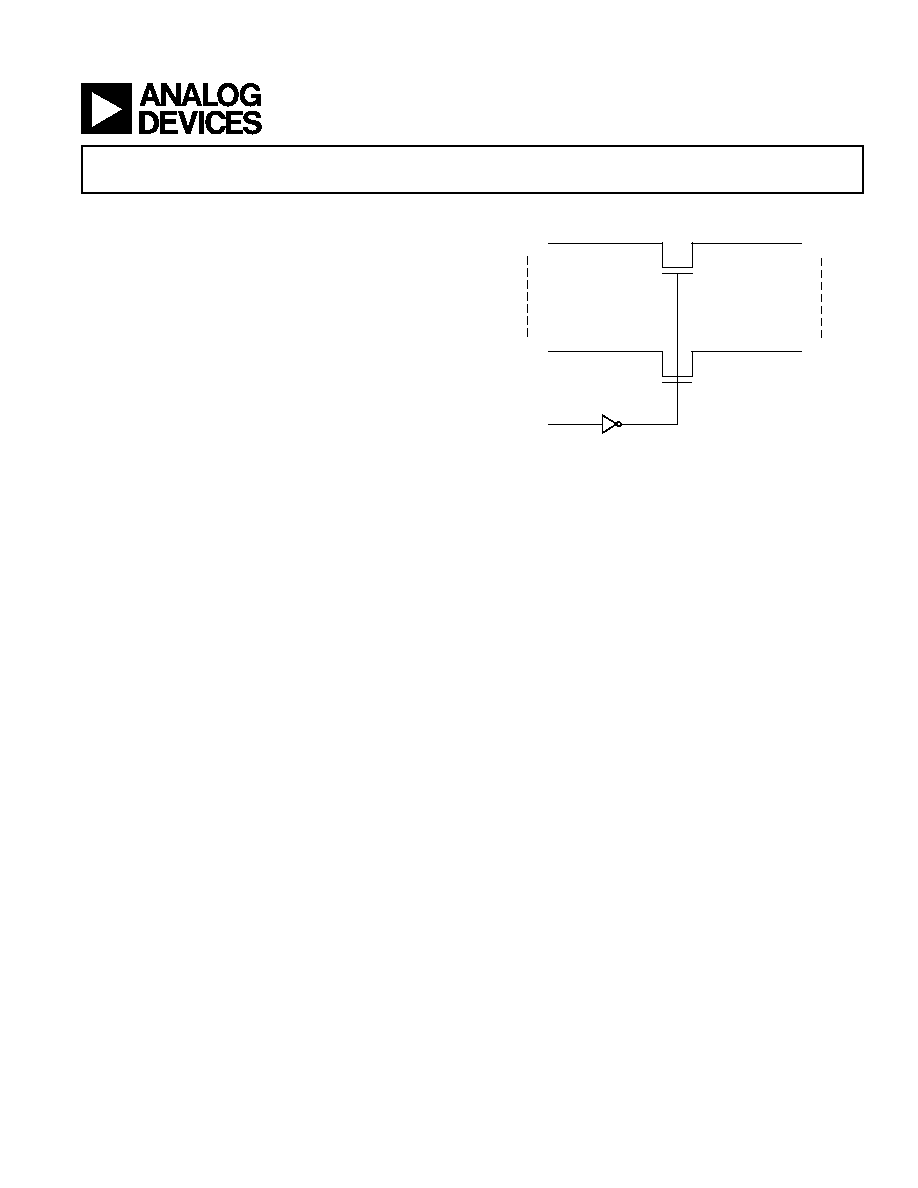
Preliminary Technical Data
PRELIMINARY TECHNICAL DATA
REV. Pr
E
ADG3245
2.5 V/3.3 V, 8-Bit, 2-Port
Level Translating, Bus Switch
Information furnished by Analog Devices is believed to be accurate and
reliable. However, no responsibility is assumed by Analog Devices for its
use, nor for any infringements of patents or other rights of third parties that
may result from its use. No license is granted by implication or otherwise
under any patent or patent rights of Analog Devices. Trademarks and
registered trademarks are the property of their respective companies.
One Technology Way, P.O. Box 9106, Norwood, MA 02062-9106, U.S.A.
Tel: 781/329-4700
www.analog.com
Fax: 781/326-8703
© 2003 Analog Devices, Inc. All rights reserved.
FEATURES
225 ps Propagation Delay through the Switch
4.5 Switch Connection between Ports
Data Rate 1.244 Gbps
2.5 V/3.3 V Supply Operation
Selectable Level Shifting/Translation
Level Translation
3.3 V to 2.5 V
3.3 V to 1.8 V
2.5 V to 1.8 V
Small Signal Bandwidth 610 MHz
20-Lead TSSOP and LFCSP Packages
APPLICATIONS
3.3 V to 1.8 V Voltage Translation
3.3 V to 2.5 V Voltage Translation
2.5 V to 1.8 V Voltage Translation
Bus Switching
Bus Isolation
Hot Swap
Hot Plug
Analog Switch Applications
FUNCTIONAL BLOCK DIAGRAM
BE
A0
B0
A7
B7
GENERAL DESCRIPTION
The ADG3245 is a 2.5 V or 3.3 V, 8-bit, 2-port digital switch.
It is designed on Analog Devices' low voltage CMOS process,
which provides low power dissipation yet gives high switching
speed and very low on resistance, allowing inputs to be connected
to outputs without additional propagation delay or generating
additional ground bounce noise.
The switches are enabled by means of the Bus Enable (
BE) input
signal. These digital switches allow bidirectional signals to be
switched when ON. In the OFF condition, signal levels up to
the supplies are blocked.
This device is ideal for applications requiring level translation.
When operated from a 3.3 V supply, level translation from 3.3 V
inputs to 2.5 V outputs is allowed. Similarly, if the device is
operated from a 2.5 V supply and 2.5 V inputs are applied, the
device will translate the outputs to 1.8 V. In addition to this, a
level translating select pin (
SEL) is included. When SEL is low,
V
CC
is reduced internally, allowing for level translation between
3.3 V inputs and 1.8 V outputs. This makes the device suited to
applications requiring level translation between different supplies,
such as converter to DSP/microcontroller interfacing.
PRODUCT HIGHLIGHTS
1. 3.3 V or 2.5 V supply operation
2. Extremely low propagation delay through switch
3. 4.5
switches connect inputs to outputs
4. Level/voltage translation
5. 20-lead TSSOP and LFCSP (4 mm
× 4 mm) packages

PRELIMINARY TECHNICAL DATA
REV. Pr
E
2
ADG3245SPECIFICATIONS
1
(V
CC
= 2.3 V to 3.6 V, GND = 0 V, all specifications T
MIN
to T
MAX
, unless
otherwise noted.)
B Version
Parameter
Symbol
Conditions
Min
Typ
2
Max
Unit
DC ELECTRICAL CHARACTERISTICS
Input High Voltage
V
INH
V
CC
= 2.7 V to 3.6 V
2.0
V
V
INH
V
CC
= 2.3 V to 2.7 V
1.7
V
Input Low Voltage
V
INL
V
CC
= 2.7 V to 3.6 V
0.8
V
V
INL
V
CC
= 2.3 V to 2.7 V
0.7
V
Input Leakage Current
I
I
±0.01
± 1
µA
OFF State Leakage Current
I
OZ
0
A, B V
CC
±0.01
± 1
µA
ON State Leakage Current
0
A, B V
CC
±0.01
± 1
µA
Max Pass Voltage
V
P
V
A
/V
B
= V
CC
=
SEL = 3.3 V, I
O
= 5
µA
2.0
2.5
2.9
V
V
A
/V
B
= V
CC
=
SEL = 2.5 V, I
O
= 5
µA
1.5
1.8
2.1
V
V
A
/V
B
= V
CC
= 3.3 V,
SEL = 0 V, I
O
= 5
µA
1.5
1.8
2.1
V
CAPACITANCE
3
A Port Off Capacitance
C
A
OFF
f = 1 MHz
5
pF
B Port Off Capacitance
C
B
OFF
f = 1 MHz
5
pF
A, B Port On Capacitance
C
A
, C
B
ON
f = 1 MHz
10
pF
Control Input Capacitance
C
IN
f = 1 MHz
6
pF
SWITCHING CHARACTERISTICS
3
Propagation Delay A to B or B to A, t
PD
4
t
PHL
, t
PLH
C
L
= 50 pF, V
CC
=
SEL = 3 V
0.225
ns
Propagation Delay Matching
5
22.5
ps
Bus Enable Time
BE to A or B
6
t
PZH
, t
PZL
V
CC
= 3.0 V to 3.6 V;
SEL = V
CC
1
3.2
4.8
ns
Bus Disable Time
BE to A or B
6
t
PHZ
, t
PLZ
V
CC
= 3.0 V to 3.6 V;
SEL = V
CC
1
3.2
4.8
ns
Bus Enable Time
BE to A or B
6
t
PZH
, t
PZL
V
CC
= 3.0 V to 3.6 V;
SEL = 0 V
0.5
2.2
3.3
ns
Bus Disable Time
BE to A or B
6
t
PHZ
, t
PLZ
V
CC
= 3.0 V to 3.6 V;
SEL = 0 V
0.5
1.7
2.9
ns
Bus Enable Time
BE to A or B
6
t
PZH
, t
PZL
V
CC
= 2.3 V to 2.7 V;
SEL = V
CC
0.5
2.2
3
ns
Bus Disable Time
BE to A or B
6
t
PHZ
, t
PLZ
V
CC
= 2.3 V to 2.7 V;
SEL = V
CC
0.5
1.75
2.6
ns
Max Data Rate
V
CC
=
SEL = 3.3 V; V
A
/V
B
= 2 V
1.244
Gbps
Channel Jitter
V
CC
=
SEL = 3.3 V; V
A
/V
B
= 2 V
50
ps p-p
Operating Frequency--Bus Enable
f
BE
10
MHz
DIGITAL SWITCH
On Resistance
R
ON
V
CC
= 3 V,
SEL = V
CC
, V
A
= 0 V, I
BA
= 8 mA
4.5
8
V
CC
= 3 V,
SEL = V
CC
, V
A
= 1.7 V, I
BA
= 8 mA
15
28
V
CC
= 2.3 V,
SEL = V
CC
, V
A
= 0 V, I
BA
= 8 mA
5
9
V
CC
= 2.3 V,
SEL = V
CC
, V
A
= 1 V, I
BA
= 8 mA
11
18
V
CC
= 3 V,
SEL = 0 V V
A
= 0 V, I
BA
= 8 mA
5
8
V
CC
= 3 V,
SEL = 0 V, V
A
= 1 V, I
BA
= 8 mA
14
On Resistance Matching
R
ON
V
CC
= 3 V,
SEL = V
CC
, V
A
= 0 V, I
BA
= 8 mA
0.45
V
CC
= 3 V,
SEL = V
CC
, V
A
= 1 V, I
BA
= 8 mA
0.65
POWER REQUIREMENTS
V
CC
2.3
3.6
V
Quiescent Power Supply Current
I
CC
Digital Inputs = 0 V or V
CC
;
SEL = V
CC
0.001
1
µA
Digital Inputs = 0 V or V
CC
;
SEL = 0 V
0.65
1.2
mA
Increase in I
CC
per Input
7
I
CC
V
CC
= 3.6 V,
BE = 3.0 V; SEL = V
CC
130
µA
NOTES
1
Temperature range is as follows: B Version: 40
°C to +85°C.
2
Typical values are at 25
°C, unless otherwise stated.
3
Guaranteed by design, not subject to production test.
4
The digital switch contributes no propagation delay other than the RC delay of the typical R
ON
of the switch and the load capacitance when driven by an ideal voltage
source. Since the time constant is much smaller than the rise/fall times of typical driving signals, it adds very little propagation delay to the system. Propagation delay
of the digital switch when used in a system is determined by the driving circuit on the driving side of the switch and its interaction with the load on the driven side.
5
Propagation delay matching between channels is calculated from the on resistance matching and load capacitance of 50 pF.
6
See Timing Measurement Information.
7
This current applies to the control pin
BE only. The A and B ports contribute no significant ac or dc currents as they transition.
Specifications subject to change without notice.

PRELIMINARY TECHNICAL DATA
REV. Pr
E
ADG3245
3
ABSOLUTE MAXIMUM RATINGS
*
(T
A
= 25
°C, unless otherwise noted.)
V
CC
to GND . . . . . . . . . . . . . . . . . . . . . . . . . 0.5 V to +4.6 V
Digital Inputs to GND . . . . . . . . . . . . . . . . . 0.5 V to +4.6 V
DC Input Voltage . . . . . . . . . . . . . . . . . . . . . 0.5 V to +4.6 V
DC Output Current . . . . . . . . . . . . . . . . . . . . . . . . . . . 120 mA
Operating Temperature Range
Industrial (B Version) . . . . . . . . . . . . . . . . . 40
°C to +85°C
Storage Temperature Range . . . . . . . . . . . . 65
°C to +150°C
Junction Temperature . . . . . . . . . . . . . . . . . . . . . . . . . . 150
°C
LFCSP Package
JA
Thermal Impedance . . . . . . . . . . . . . . . . . . . . . 30.4
°C/W
TSSOP Package
JA
Thermal Impedance . . . . . . . . . . . . . . . . . . . . 143
°C/W
Lead Temperature, Soldering (10 seconds) . . . . . . . . . . 300
°C
IR Reflow, Peak Temperature (<20 seconds) . . . . . . . . 235
°C
*Stresses above those listed under Absolute Maximum Ratings may cause perma-
nent damage to the device. This is a stress rating only; functional operation of the
device at these or any other conditions above those listed in the operational
sections of this specification is not implied. Exposure to absolute maximum rating
conditions for extended periods may affect device reliability. Only one absolute
maximum rating may be applied at any one time.
Table I. Pin Description
Pin Mnemonic
Description
BE
Bus Enable (Active Low)
SEL
Level Translation Select
Ax
Port A, Inputs or Outputs
Bx
Port B, Inputs or Outputs
Table II. Truth Table
BE
SEL*
Function
L
L
A = B, 3.3 V to 1.8 V Level Shifting
L
H
A = B, 3.3 V to 2.5 V/2.5 V to 1.8 V Level Shifting
H
X
Disconnect
*SEL = 0 V only when VDD = 3.3 V
± 10%
PIN CONFIGURATION
20-Lead LFCSP and 20-Lead TSSOP
15
BE
14 B0
13 B1
12 B2
SEL 1
A4 2
A5 3
20 A3
11 B3
GND 6
B7 7
B6 8
B5 9
B4 10
A6 4
A7 5
19 A2
18 A1
17 A0
16 V
CC
PIN 1
INDICATOR
TOP VIEW
ADG3245
TOP VIEW
(Not to Scale)
20
19
18
17
16
15
14
13
12
11
1
2
3
4
5
6
7
8
9
10
ADG3245
GND
A7
A6
A0
A1
A2
A5
A4
A3
B7
B6
B5
BE
B0
B1
B4
B3
B2
SEL
V
CC
CAUTION
ESD (electrostatic discharge) sensitive device. Electrostatic charges as high as 4000 V readily
accumulate on the human body and test equipment and can discharge without detection. Although the
ADG3245 features proprietary ESD protection circuitry, permanent damage may occur on devices
subjected to high energy electrostatic discharges. Therefore, proper ESD precautions are recommended
to avoid performance degradation or loss of functionality.
ORDERING GUIDE
Model
Temperature Range
Package Description
Package Option
ADG3245BCP
40
°C to +85°C
Leaded Chip Scale Package (LFCSP)
CP-20
ADG3245BRU
40
°C to +85°C
Thin Shrink Small Outline Package (TSSOP)
RU-20

PRELIMINARY TECHNICAL DATA
REV. Pr
E
4
ADG3245
TERMINOLOGY
V
CC
Positive Power Supply Voltage
GND
Ground (0 V) Reference
V
INH
Minimum Input Voltage for Logic 1
V
INL
Maximum Input Voltage for Logic 0
I
I
Input Leakage Current at the Control Inputs
I
OZ
OFF State Leakage Current. It is the maximum leakage current at the switch pin in the OFF state.
I
OL
ON State Leakage Current. It is the maximum leakage current at the switch pin in the ON state.
V
P
Max Pass Voltage. The max pass voltage relates to the clamped output voltage of an NMOS device when the switch
input voltage is equal to the supply voltage.
R
ON
Ohmic Resistance Offered by a Switch in the ON State. It is measured at a given voltage by forcing a specified
amount of current through the switch.
R
ON
On Resistance Match between Any Two Channels, i.e., R
ON
Max - R
ON
Min
C
X
OFF
OFF Switch Capacitance
C
X
ON
ON Switch Capacitance
C
IN
Control Input Capacitance. This consists of
BE and SEL.
I
CC
Quiescent Power Supply Current. This current represents the leakage current between the V
CC
and ground pins.
It is measured when all control inputs are at a logic HIGH or LOW level and the switches are OFF.
I
CC
Extra Power Supply Current Component for the
BE Control Input when the input is not driven at the supplies.
t
PLH
, t
PHL
Data Propagation Delay Through the Switch in the ON State. Propagation delay is related to the RC time constant
R
ON
× C
L
, where C
L
is the load capacitance.
t
PZH
, t
PZL
Bus Enable Times. These are the times taken to cross the V
T
voltage at the switch output when the switch turns on
in response to the control signal,
BE.
t
PHZ
, t
PLZ
Bus Disable Times. This is the time taken to place the switch in the high impedance OFF state in response to the con-
trol signal. It is measured as the time taken for the output voltage to change by V from the original quiescent level,
with reference to the logic level transition at the control input. (Refer to Figure 3 for enable and disable times.)
Max Data Rate
Maximum Rate at which Data Can Be Passed through the Switch
Channel Jitter
Peak-to-Peak Value of the Sum of the Deterministic and Random Jitter of the Switch Channel
f
BE
Operating Frequency of Bus Enable. This is the maximum frequency at which Bus Enable (
BE) can be toggled.
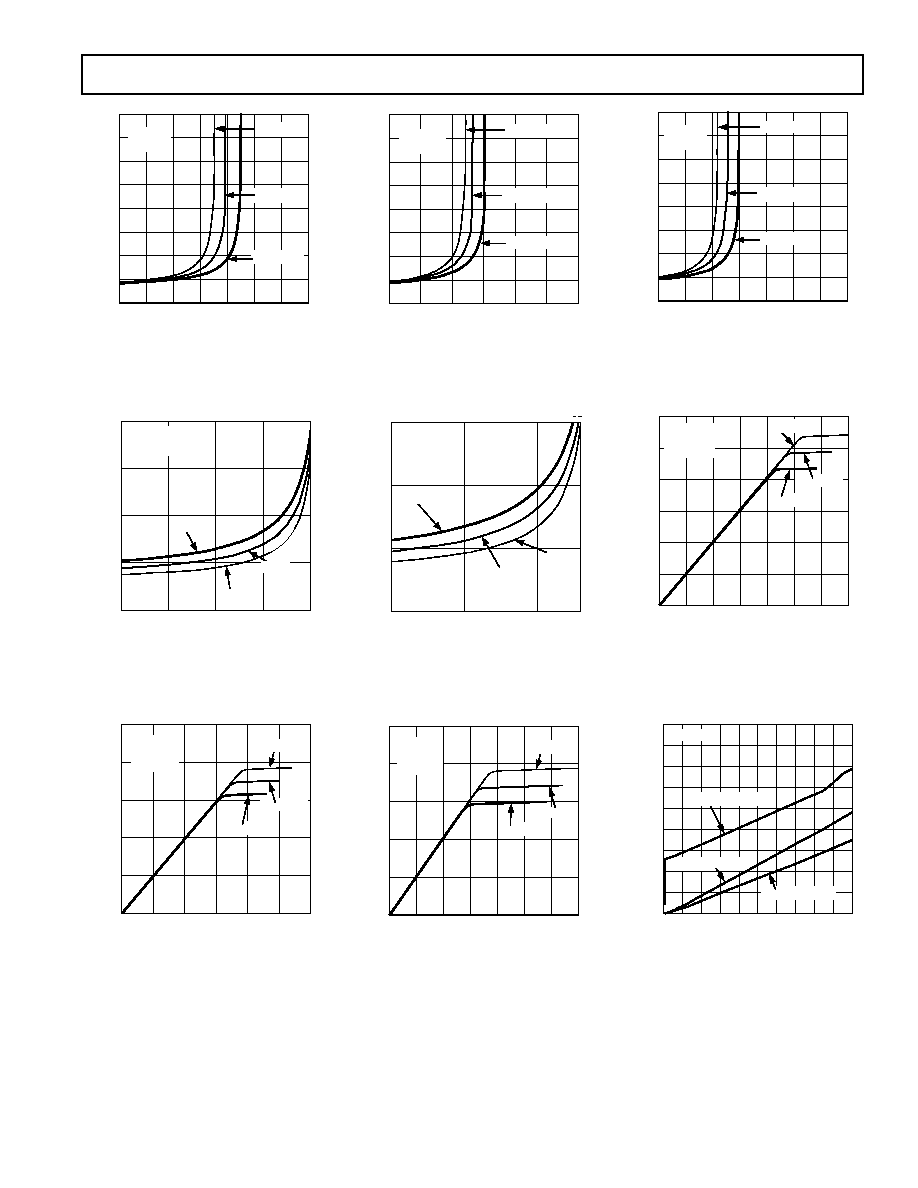
PRELIMINARY TECHNICAL DATA
REV. Pr
E
Typical Performance CharacteristicsADG3245
5
V
A
/V
B
V
R
ON
0
0
0.5
T
A
= 25 C
SEL = V
CC
5
10
15
20
25
30
35
40
1.5
2.5
3.5
V
CC
= 3V
V
CC
= 3.3V
V
CC
= 3.6V
3.0
2.0
1.0
TPC 1. On Resistance vs.
Input Voltage
V
A
/V
B
V
R
ON
0
0
0.5
5
10
15
20
1.5
2.0
1.0
25 C
85 C
40 C
= 3.3V
SEL = V
CC
V
CC
TPC 4. On Resistance vs. Input
Voltage for Different Temperatures
V
CC
V
V
OUT
V
0
0
0.5
0.5
1.5
2.5
1.5
2.5
V
CC
= 2.7V
V
CC
= 2.5V
V
CC
= 2.3V
T
A
= 25 C
SEL = V
CC
I
O
= 5 A
2.0
1.0
1.0
2.0
3.0
TPC 7. Pass Voltage vs. V
CC
V
A
/V
B
V
R
ON
0
0
0.5
5
10
15
20
25
30
35
40
1.5
2.5
V
CC
= 2.3V
V
CC
= 2.5V
V
CC
= 2.7V
T
A
= 25 C
SEL = V
CC
3.0
2.0
1.0
TPC 2. On Resistance vs.
Input Voltage
V
A
/V
B
V
R
ON
0
0
0.5
5
10
15
85 C
25 C
1.0
40 C
= 2.5V
SEL = V
CC
V
CC
1.2
TPC 5. On Resistance vs. Input
Voltage for Different Temperatures
V
CC
V
V
OUT
V
0
0
0.5
0.5
1.5
2.5
1.5
2.5
V
CC
= 3.6V
V
CC
= 3.3V
V
CC
= 3V
3.5
T
A
= 25 C
SEL = 0V
I
O
= 5 A
2.0
1.0
1.0
2.0
3.0
TPC 8. Pass Voltage vs. V
CC
V
A
/V
B
V
R
ON
0
0
0.5
5
10
15
20
25
30
35
40
1.5
2.5
V
CC
= 3V
V
CC
= 3.3V
V
CC
= 3.6V
3.5
T
A
= 25 C
SEL = 0V
1.0
2.0
3.0
TPC 3. On Resistance vs.
Input Voltage
V
CC
V
V
OUT
V
0
0
0.5
0.5
1.5
2.5
1.5
2.5
3.5
V
CC
= 3.6V
V
CC
= 3.3V
V
CC
= 3V
3.0
2.0
1.0
1.0
2.0
3.0
T
A
= 25 C
SEL = V
CC
I
O
= 5 A
TPC 6. Pass Voltage vs. V
CC
ENABLE FREQUENCY MHz
I
CC
A
0
0
2
4
200
6
8
10
T
A
= 25 C
12
V
CC
= 3.3V,
SEL = 0V
14 16
18 20
400
600
800
1000
1200
1400
1600
1800
V
CC
=
SEL = 3.3V
V
CC
=
SEL = 2.5V
TPC 9. I
CC
vs. Enable Frequency
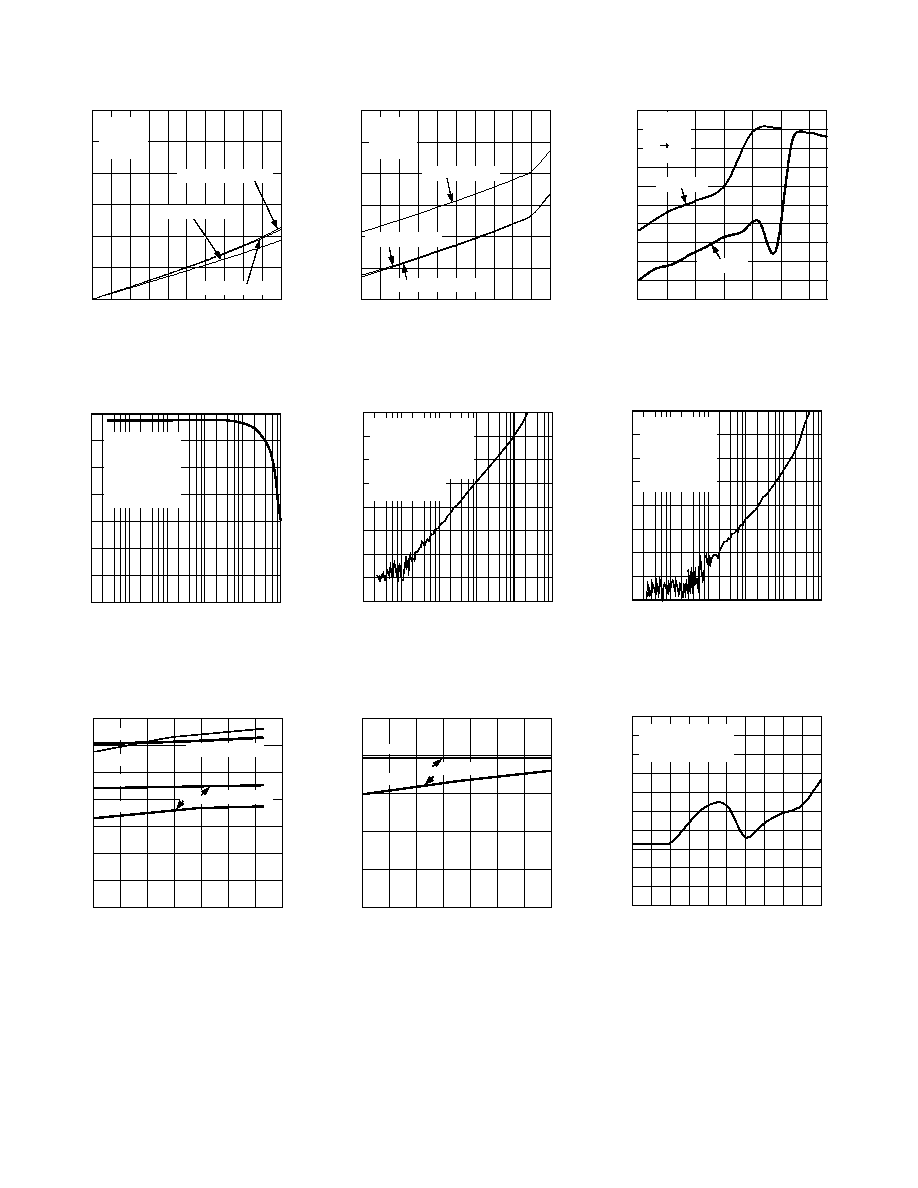
PRELIMINARY TECHNICAL DATA
REV. Pr
E
6
ADG3245
I
O
A
V
OUT
V
0
0.01
0.5
1.0
1.5
2.0
2.5
3.0
0.02 0.03 0.04 0.05 0.06 0.07 0.08 0.09 0.10
0
V
CC
= 3.3V;
SEL = 0V
V
CC
=
SEL = 3.3V
V
CC
=
SEL = 2.5V
T
A
= 25 C
V
A
= 0V
BE = 0
TPC 10. Output Low Characteristic
FREQUENCY MHz
A
TTENU
A
TION dB
0
0.03
0.1
1000
2
1
10
100
4
6
8
10
12
T
A
= 25 C
V
CC
= 3.3V/2.5V
SEL = V
CC
V
IN
= 0dBm
N/W ANALYZER :
R
L
= R
S
= 50
14
TPC 13. Bandwidth vs. Frequency
TEMPERATURE C
0
40
0.5
1.5
2.5
3.5
20
0
20
40
60
80
100
ENABLE
DISABLE
ENABLE
DISABLE
V
CC
=
SEL = 3.3V
V
CC
= 3.3V,
SEL = 0V
3.0
2.0
1.0
TIME ns
TPC 16. Enable/Disable Time
vs. Temperature
I
O
A
V
OUT
V
0
0.10
0.5
1.0
1.5
2.0
2.5
3.0
0
T
A
= 25 C
V
A
= V
CC
BE = 0
0.09 0.08 0.07 0.06 0.05 0.04 0.03 0.02 0.01
V
CC
=
SEL = 2.5V
V
CC
= 3.3V;
SEL = 0V
V
CC
=
SEL = 3.3V
TPC 11. Output High Characteristic
FREQUENCY MHz
A
TTENU
A
TION dB
0.03
0.1
1000
1
10
100
80
90
70
60
50
40
30
20
100
T
A
= 25 C
V
CC
= 3.3V/2.5V
SEL = V
CC
ADJACENT CHANNELS
V
IN
= 0dBm
N/W ANALYZER :
R
L
= R
S
= 50
TPC 14. Crosstalk vs. Frequency
TEMPERATURE C
TIME ns
0
40
0.5
1.5
2.5
20
0
20
40
60
80
100
ENABLE
DISABLE
V
CC
=
SEL = 2.5V
2.0
1.0
TPC 17. Enable/Disable Time
vs. Temperature
V
A
/V
B
V
Q
INJ
pC
2.0
0
0.5
1.0
0.2
1.5
2.5
0.4
0.6
0.8
1.2
1.4
1.8
1.0
2.0
3.0
1.6
0
V
CC
= 3.3V
V
CC
= 2.5V
T
A
= 25 C
SEL = V
CC
ON OFF
C
L
= InF
TPC 12. Charge Injection vs.
Source Voltage
FREQUENCY MHz
A
TTENU
A
TION dB
0.03
0.1
1000
1
10
100
80
90
70
60
50
40
30
20
T
A
= 25 C
V
CC
= 3.3V/2.5V
SEL = V
CC
V
IN
= 0dBm
N/W ANALYZER :
R
L
= R
S
= 50
100
TPC 15. Off Isolation vs.
Frequency
DATA RATE GBPS
JITTER ps
0.5 0.6
60
70
80
90
100
50
0.7 0.8 0.9
1.1 1.2 1.3 1.4 1.5
1.0
40
30
20
10
0
V
CC
=
SEL = 3.3V
V
IN
= 2V p-p
20dB ATTENUATION
TPC 18. Jitter vs. Data Rate;
PRBS 31
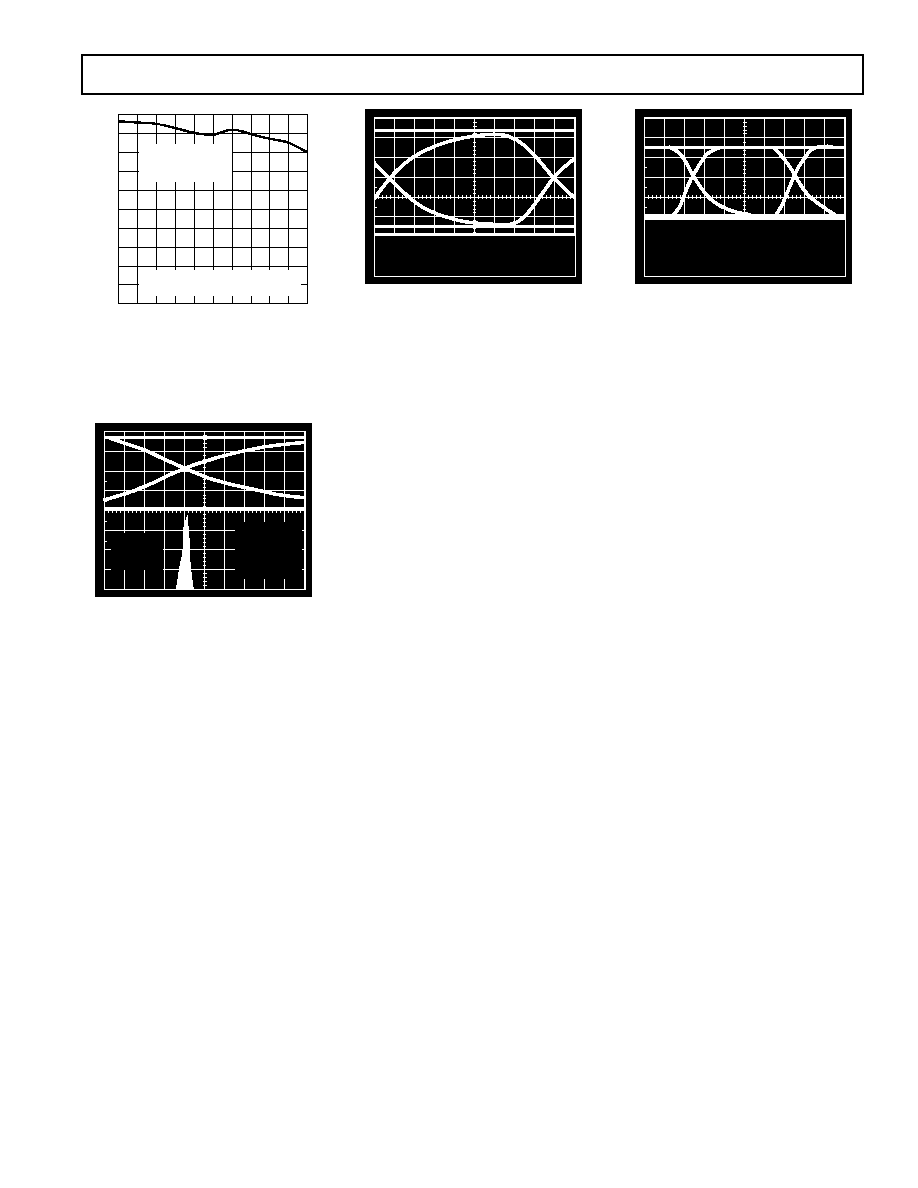
PRELIMINARY TECHNICAL DATA
REV. Pr
E
ADG3245
7
DATA RATE GBPS
EYE WIDTH %
0.5 0.6
60
70
80
85
90
95
100
% EYE WIDTH = ((CLOCK PERIOD
JITTER p-p)/CLOCK PERIOD) 100%
75
65
55
50
0.7 0.8 0.9
1.1 1.2 1.3 1.4 1.5
1.0
V
CC
=
SEL = 3.3V
V
IN
= 2V p-p
20dB ATTENUATION
TPC 19. Eye Width vs. Data
Rate; PRBS 31
50.1mV/DIV
50ps/DIV
T
A
= 25 C
20dB
ATTENUATION
V
CC
= 3.3V
SEL = 3.3V
V
IN
= 2V p-p
TPC 22. Jitter @ 1.244 GBPS,
PRBS 31
V
CC
= 3.3V
SEL = 3.3V
V
IN
= 2V p-p
20dB
ATTENUATION
T
A
= 25 C
35mV/DIV
100ps/DIV
TPC 20. Eye Pattern; 1.244
GBPS, V
CC
= 3.3 V, PRBS 31
37mV/DIV
200ps/DIV
V
CC
= 2.5V
SEL = 2.5V
V
IN
= 2V p-p
20dB
ATTENUATION
T
A
= 28 C
TPC 21. Eye Pattern; 1 GBPS,
V
CC
= 2.5 V, PRBS 31
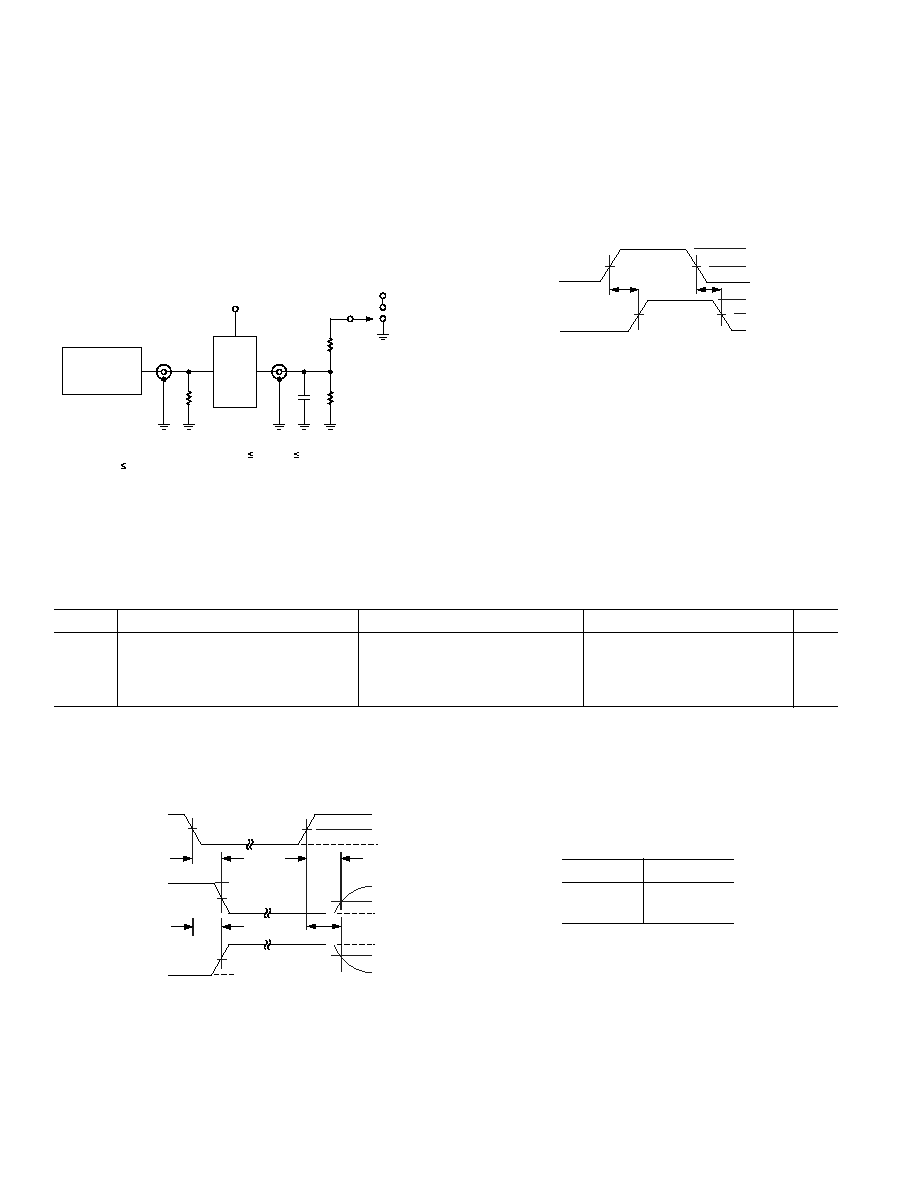
PRELIMINARY TECHNICAL DATA
REV. Pr
E
8
ADG3245
For the following load circuit and waveforms, the notation that
is used is V
IN
and V
OUT
where:
V
V and V
V
or
V
V and V
V
IN
A
OUT
B
IN
B
OUT
A
=
=
=
=
CONTROL
INPUT
BE
0V
t
PLH
V
OUT
V
T
V
IH
V
H
V
T
V
L
t
PLH
Figure 2. Propagation Delay
V
CC
V
IN
V
OUT
C
L
R
L
R
L
SW1
GND
2 V
CC
R
T
D.U.T.
PULSE
GENERATOR
NOTES
PULSE GENERATOR FOR ALL PULSES:
t
R
2.5ns,
t
F
2.5ns,
FREQUENCY 10MHz
C
L
INCLUDES BOARD, STRAY, AND LOAD CAPACITANCES.
R
T
IS THE TERMINATION RESISTOR, SHOULD BE EQUAL TO Z
OUT
OF THE PULSE GENERATOR.
Figure 1. Load Circuit
Test Conditions
Symbol
V
CC
= 3.3 V
± 0.3 V (SEL = V
CC
)
V
CC
= 2.5 V
± 0.2 V (SEL = V
CC
)
V
CC
= 3.3 V
± 0.3 V (SEL = 0 V) Unit
R
L
500
500
500
V
300
150
150
mV
C
L
50
30
30
pF
V
T
1.5
0.9
0.9
V
TIMING MEASUREMENT INFORMATION
ENABLE
DISABLE
CONTROL INPUT
BE
V
IN
= 0V
V
IN
= V
CC
V
OUT
SW1 @ 2V
CC
V
OUT
SW1 @ GND
t
PLZ
t
PZH
t
PHZ
t
PZL
V
T
0V
V
CC
V
T
V
H
V
H
V
V
L
V
L
+ V
V
CC
0V
V
T
V
INH
0V
Figure 3. Enable and Disable Times
Table III. Switch Position
TEST
S1
t
PLZ
, t
PZL
2
× V
CC
t
PHZ
, t
PZH
GND
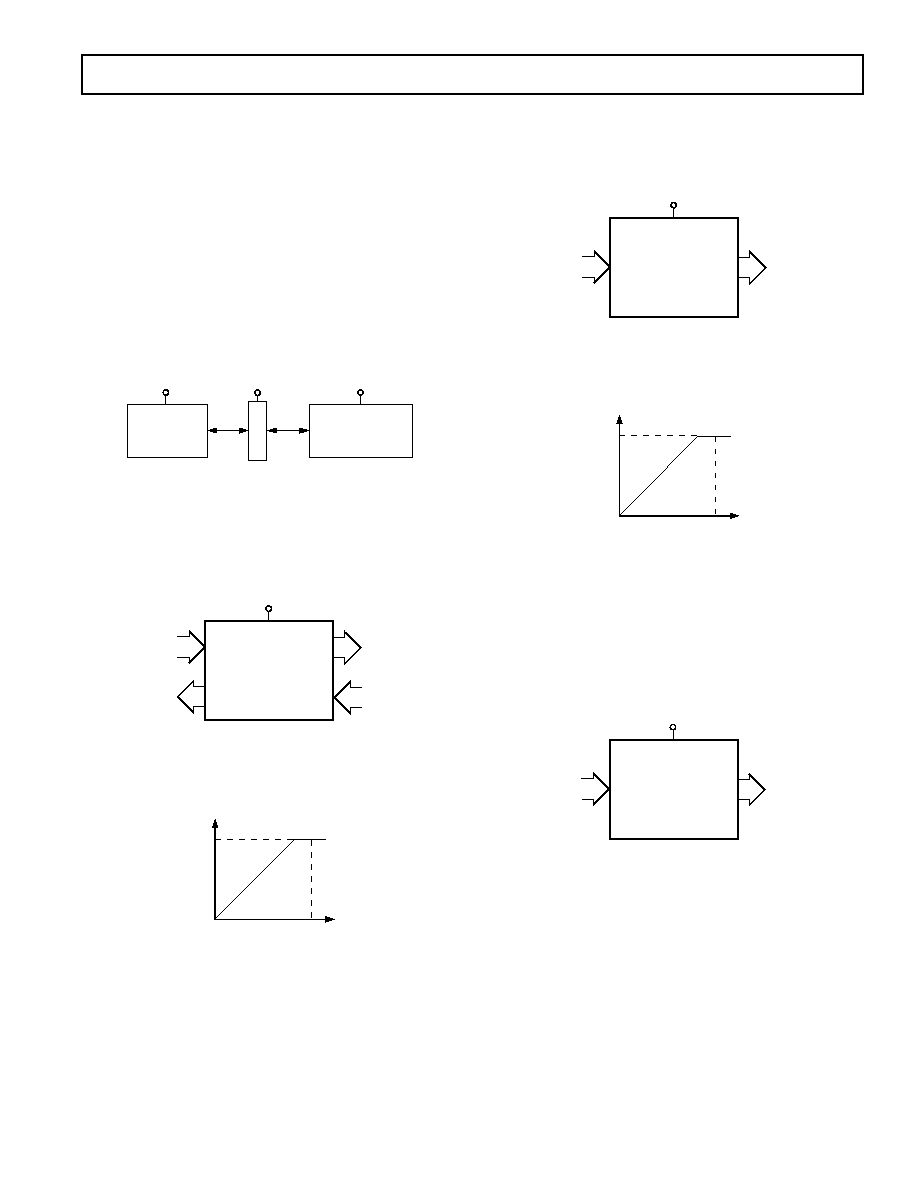
PRELIMINARY TECHNICAL DATA
REV. Pr
E
ADG3245
9
BUS SWITCH APPLICATIONS
Mixed Voltage Operation, Level Translation
Bus switches can be used to provide an ideal solution for inter-
facing between mixed voltage systems. The ADG3245 is suitable
for applications where voltage translation from 3.3 V technology
to a lower voltage technology is needed. This device can translate
from 3.3 V to 1.8 V, from 2.5 V to 1.8 V, or bidirectionally
from 3.3 V directly to 2.5 V.
Figure 4 shows a block diagram of a typical application in which
a user needs to interface between a 3.3 V ADC and a 2.5 V
microprocessor. The microprocessor may not have 3.3 V toler-
ant inputs, therefore placing the ADG3245 between the two
devices allows the devices to communicate easily. The bus
switch directly connects the two blocks, thus introducing
minimal propagation delay, timing skew, or noise.
3.3V ADC
2.5V
3.3V
2.5V
MICROPROCESSOR
ADG3245
3.3V
Figure 4. Level Translation between a 3.3 V ADC
and a 2.5 V Microprocessor
3.3 V to 2.5 V Translation
When V
CC
is 3.3 V (
SEL = 3.3 V) and the input signal range is
0 V to V
CC
, the max output signal will be clamped to within a
voltage threshold below the V
CC
supply.
ADG3245
2.5V
2.5V
3.3V
2.5V
3.3V
Figure 5. 3.3 V to 2.5 V Voltage Translation,
SEL = 3.3 V
In this case, the output will be limited to 2.5 V, as shown in
Figure 6.
V
IN
2.5V
V
OUT
0V
3.3V
SWITCH
INPUT
S
WITCH
OU
TPUT
3.3V SUPPLY
SEL = 3.3V
Figure 6. 3.3 V to 2.5 V Voltage Translation,
SEL = 3.3 V
This device can be used for translation from 2.5 V to 3.3 V
devices, and also between two 3.3 V devices.
2.5 V to 1.8 V Translation
When V
CC
is 2.5 V (
SEL = 2.5 V) and the input signal range is
0 V to V
CC
, the max output signal will, as before, be clamped to
within a voltage threshold below the V
CC
supply.
ADG3245
1.8V
2.5V
2.5V
Figure 7. 2.5 V to 1.8 V Voltage Translation,
SEL = 2.5 V
In this case, the output will be limited to approximately
1.8 V, as shown in Figure 7.
V
IN
1.8V
V
OUT
0V
2.5V
SWITCH
INPUT
S
WITCH
OU
TPUT
2.5V SUPPLY
SEL = 2.5V
Figure 8. 2.5 V to 1.8 V Voltage Translation,
SEL = 2.5 V
3.3 V to 1.8 V Translation
The ADG3245 offers the option of interfacing between a 3.3 V
device and a 1.8 V device. This is possible through use of the
SEL pin.
SEL pin: An active low control pin. SEL activates internal
circuitry in the ADG3245 that allows voltage translation
between 3.3 V devices and 1.8 V devices.
ADG3245
1.8V
3.3V
3.3V
Figure 9. 3.3 V to 1.8 V Voltage Translation,
SEL = 0 V
When V
CC
is 3.3 V and the input signal range is 0 V to V
CC
, the
max output signal will be clamped to 1.8 V, as shown in Figure 9.
To do this, the
SEL pin must be tied to Logic 0. If SEL is
unused, it should be tied directly to V
CC
.

PRELIMINARY TECHNICAL DATA
REV. Pr
E
10
ADG3245
V
IN
1.8V
V
OUT
0V
3.3V
SWITCH
INPUT
S
WITCH
OU
TPUT
3.3V SUPPLY
SEL = 0V
Figure 10. 3.3 V to 1.8 V Voltage Translation,
SEL = 0 V
Bus Isolation
A common requirement of bus architectures is low capacitance
loading of the bus. Such systems require bus bridge devices that
extend the number of loads on the bus without exceeding the
specifications. Because the ADG3245 is designed specifically for
applications that do not need drive yet require simple logic
functions, it solves this requirement. The device isolates access
to the bus, thus minimizing capacitance loading.
BUS/
BACKPLANE
LOAD A
LOAD C
LOAD B
LOAD D
BUS SWITCH
LOCATION
Figure 11. Location of Bus Switched in a Bus
Isolation Application
Hot Plug and Hot Swap Isolation
The ADG3245 is suitable for hot swap and hot plug applications.
The output signal of the ADG3245 is limited to a voltage that is
below the V
CC
supply, as shown in Figures 6, 8, and 10. Therefore
the switch acts like a buffer to take the impact from hot insertion,
protecting vital and expensive chipsets from damage.
In hot-plug applications, the system cannot be shutdown when
new hardware is being added. To overcome this, a bus switch can
be positioned on the backplane between the bus devices and the
hot plug connectors. The bus switch is turned off during hot plug.
Figure 12 shows a typical example of this type of application.
PLUG-IN
CARD (1)
CARD I/O
CARD I/O
RAM
CPU
PLUG-IN
CARD (2)
ADG3245
ADG3245
Figure 12. ADG3245 in a Hot Plug Application
There are many systems that require the ability to handle hot
swapping, such as docking stations, PCI boards for servers, and
line cards for telecommunications switches. If the bus can be
isolated prior to insertion or removal, then there is more control
over the hot swap event. This isolation can be achieved using a
bus switch. The bus switches are positioned on the hot swap card
between the connector and the devices. During hot swap, the
ground pin of the hot swap card must connect to the ground pin
of the back plane before any other signal or power pins.
Analog Switching
Bus switches can be used in many analog switching applications;
for example, video graphics. Bus switches can have lower on
resistance, smaller ON and OFF channel capacitance and thus
improved frequency performance than their analog counterparts.
The bus switch channel itself consisting solely of an NMOS
switch limits the operating voltage (see TPC 1 for a typical
plot), but in many cases this does not present an issue.
High Impedance During Power-Up/Power-Down
To ensure the high impedance state during power-up or power-
down,
BE should be tied to V
CC
through a pull-up resistor; the
minimum value of the resistor is determined by the current-
sinking capability of the driver.
PACKAGE AND PINOUT
The ADG3245 is packaged in both a small 20-lead TSSOP or a
tiny 20-lead LFCSP package. The area of the TSSOP option is
37.5 mm
2
, while the area of the LFCSP option is 16 mm
2
. This
leads to a 57% savings in board space when using the LFCSP pack-
age compared with the TSSOP package. This makes the LFCSP
option an excellent choice for space-constrained applications.
The ADG3245 in the TSSOP package offers a flowthrough
pinout. The term flowthrough signifies that all the inputs are on
opposite sides from the outputs. A flowthrough pinout simplifies
the PCB layout.
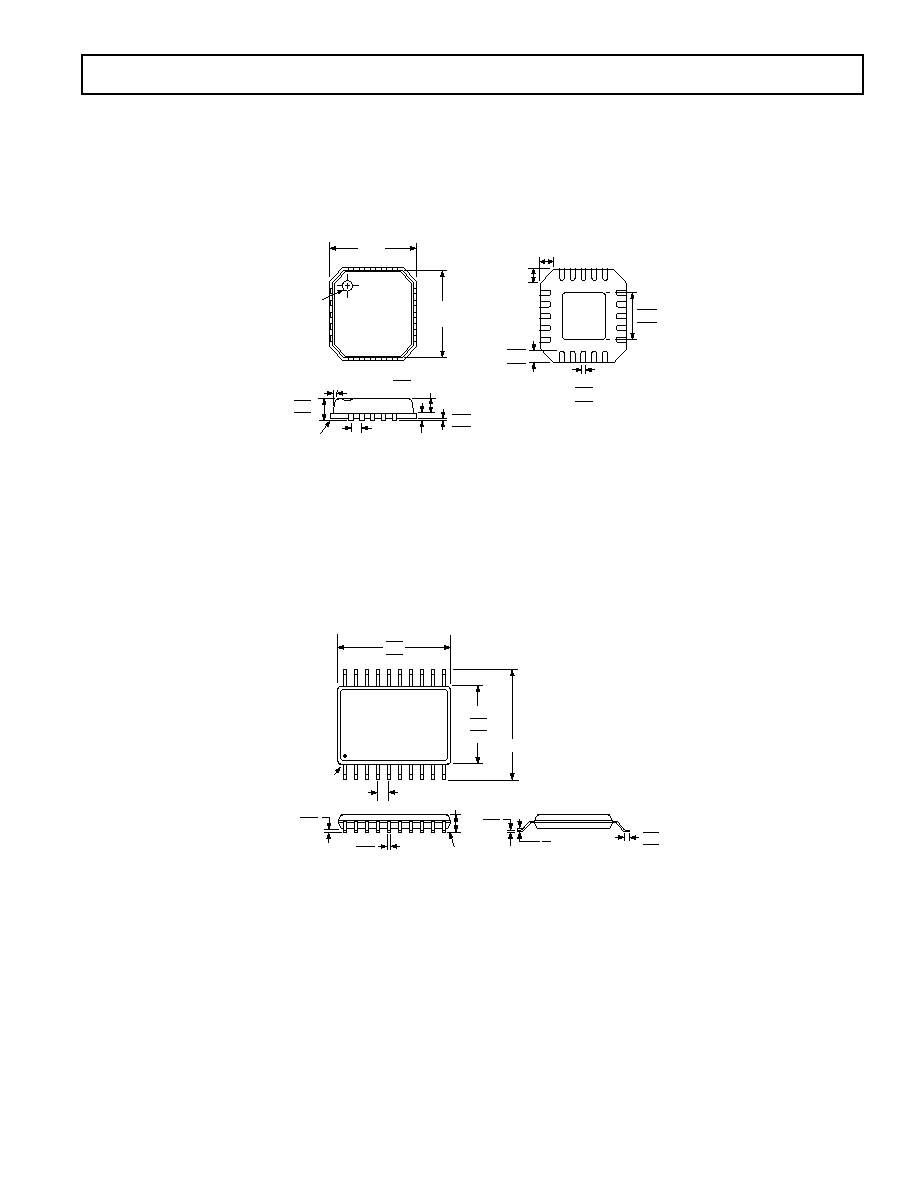
PRELIMINARY TECHNICAL DATA
REV. Pr
E
ADG3245
11
OUTLINE DIMENSIONS
20-Lead Chip Scale Package [LFCSP]
4 4 mm Body
(CP-20)
Dimensions shown in millimeters
1
20
5
6
11
16
15
BOTTOM
VIEW
10
2.25
2.10 SQ
1.95
0.75
0.55
0.35
0.30
0.23
0.18
0.50
BSC
12
MAX
0.25
REF
0.70 MAX
0.65 NOM
0.05
0.02
0.00
1.00
0.90
0.80
SEATING
PLANE
PIN 1
INDICATOR
TOP
VIEW
3.75
BSC SQ
4.0
BSC SQ
COPLANARITY
0.08
COMPLIANT TO JEDEC STANDARDS MO-220-VGGD-1
0.60
MAX
0.60
MAX
20-Lead Thin Shrink Small Outline Package [TSSOP]
(RU-20)
Dimensions shown in millimeters
20
1
11
10
6.40 BSC
4.50
4.40
4.30
PIN 1
6.60
6.50
6.40
SEATING
PLANE
0.15
0.05
0.30
0.19
0.65
BSC
1.20
MAX
0.20
0.09
0.75
0.60
0.45
8
0
COMPLIANT TO JEDEC STANDARDS MO-153AC
COPLANARITY
0.10

C0301102/03(Pr
E
)
PRINTED IN U.S.A.
12











